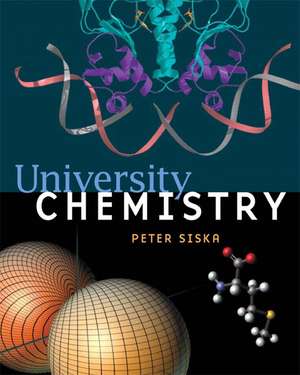University Chemistry with Student Access Kit for MasteringGeneralChemistry: United States Edition
Autor Peter E. Siskaen Limba Engleză Mixed media product – 11 dec 2005
Modern topics, such as the spectroscopic applications of quantum chemistry, are woven into the text to ignite students' imaginations and give them an appreciation for the experimental nature of the science. Rigorous in its quantitative coverage, University Chemistry helps students think through chemical problems, integrate ideas, and approach chemistry conceptually as well as mathematically.
The book's superior media program draws on the most state-of-the-art animations, simulations, and interactive chemical equations to help students visualize complex chemical processes and master problem-solving techniques.
Preț: 945.62 lei
Preț vechi: 1228.08 lei
-23% Nou
Puncte Express: 1418
Preț estimativ în valută:
180.94€ • 189.43$ • 149.72£
180.94€ • 189.43$ • 149.72£
Disponibilitate incertă
Doresc să fiu notificat când acest titlu va fi disponibil:
Se trimite...
Preluare comenzi: 021 569.72.76
Specificații
ISBN-13: 9780805330762
ISBN-10: 0805330763
Pagini: 960
Dimensiuni: 203 x 254 mm
Greutate: 1.75 kg
Ediția:1
Editura: Pearson Education
Colecția Prentice Hall
Locul publicării:Upper Saddle River, United States
ISBN-10: 0805330763
Pagini: 960
Dimensiuni: 203 x 254 mm
Greutate: 1.75 kg
Ediția:1
Editura: Pearson Education
Colecția Prentice Hall
Locul publicării:Upper Saddle River, United States
Cuprins
1. Physical Principles Underlying Chemistry.
2. The Quantum Revolution: The Failure of Everyday Notions to Apply to Atoms.
3. Wave Mechanics and the Hydrogen Atom: Quantum Numbers, Energy Levels, and Orbitals.
4. Atoms with Many Electrons and the Periodic Table.
5. Valence Electron Configurations, Periodicity, and Chemical Behavior.
6. Orbitals and Chemical Bonding I: The Valence Bond Model and Molecular Geometry.
7. Orbitals and Chemical Bonding II: The Molecular Orbital Model and Molecular Energy Levels.
8. Molecular Motion and Spectroscopy.
9. Properties of Gases and the Kinetic Molecular Theory.
10. Energy Changes in Chemical Reactions.
11. Spontaneity of Chemical Reactions.
12. Free Energy and Chemical Equilibrium.
13. Electrochemistry.
14. States of Matter and Intermolecular Forces.
15. Rates and Mechanisms of Chemical Reactions.
16. The Nucleus.
17. The Transition Metals.
18. The Chemistry of Carbon.
Appendix A: Blackbody Radiation.
Appendix B: Particle in a Box.
Appendix C: Selected Values of Thermodynamic Properties at 298.15K and 1 atm.
Appendix D: A Brief Look at Statistical Thermodynamics.
2. The Quantum Revolution: The Failure of Everyday Notions to Apply to Atoms.
3. Wave Mechanics and the Hydrogen Atom: Quantum Numbers, Energy Levels, and Orbitals.
4. Atoms with Many Electrons and the Periodic Table.
5. Valence Electron Configurations, Periodicity, and Chemical Behavior.
6. Orbitals and Chemical Bonding I: The Valence Bond Model and Molecular Geometry.
7. Orbitals and Chemical Bonding II: The Molecular Orbital Model and Molecular Energy Levels.
8. Molecular Motion and Spectroscopy.
9. Properties of Gases and the Kinetic Molecular Theory.
10. Energy Changes in Chemical Reactions.
11. Spontaneity of Chemical Reactions.
12. Free Energy and Chemical Equilibrium.
13. Electrochemistry.
14. States of Matter and Intermolecular Forces.
15. Rates and Mechanisms of Chemical Reactions.
16. The Nucleus.
17. The Transition Metals.
18. The Chemistry of Carbon.
Appendix A: Blackbody Radiation.
Appendix B: Particle in a Box.
Appendix C: Selected Values of Thermodynamic Properties at 298.15K and 1 atm.
Appendix D: A Brief Look at Statistical Thermodynamics.
Notă biografică
Peter Siska is a professor of chemistry at the University of Pittsburgh, one of the top chemistry departments in the country. Peter is a physical chemist, trained at Harvard, who works on the chemistry of electronically excited molecules. He has published numerous papers in the best journals. In addition to his research, Peter is also well known for his teaching and has been recognized for his contributions in the classroom. This year he was awarded the Bellet Arts and Sciences Excellence in Teaching, and in 1987, he received the Chancellor's Distinguished Teaching Award.
Caracteristici
- A framework organization that focuses on fundamental ideas such as the electrical nature of matter and the notion of potential energy to help explain and unify many diverse chemical phenomena.
- Connections to modern chemistry are woven throughout the text. Coverage of topics such as computers in chemistry, modern materials in chemistry, and enzymatic catalysts expose students to new areas of research.
- Experimental difficulties and challenges are discussed during the description of fundamental concepts, giving students an appreciation for the experimental nature of chemistry.
- Spectroscopy is introduced early to illustrate the natural applications of quantum chemistry in modern research.
- Superior treatment of molecular orbitals includes a separate chapter on the subject and better use of molecular orbitals in the coverage of transition metals (ligand field theory).
- An unparalleled art program uses molecular modeling software for cutting-edge illustrations that help students visualize chemistry on a molecular level.
- A superior media package includes state-of-the-art animations, simulations, and Mathematica software that help students visualize complex chemical phenomena and master problem-solving techniques.
